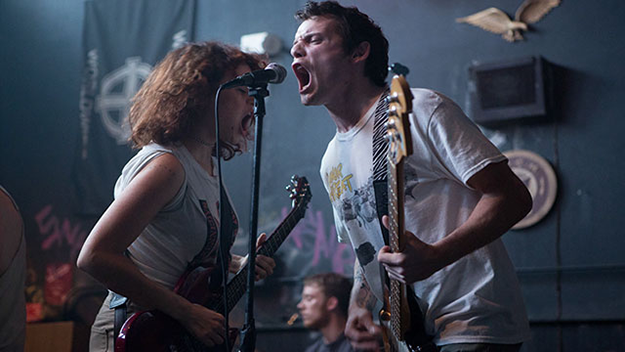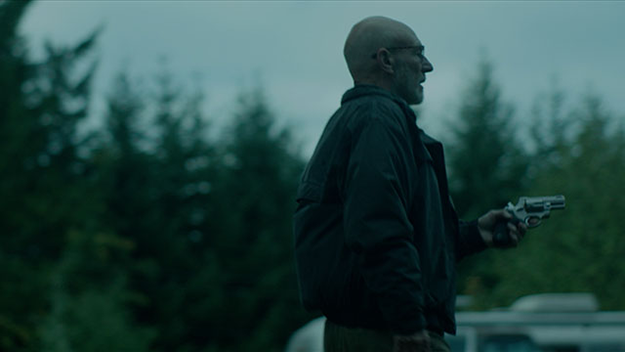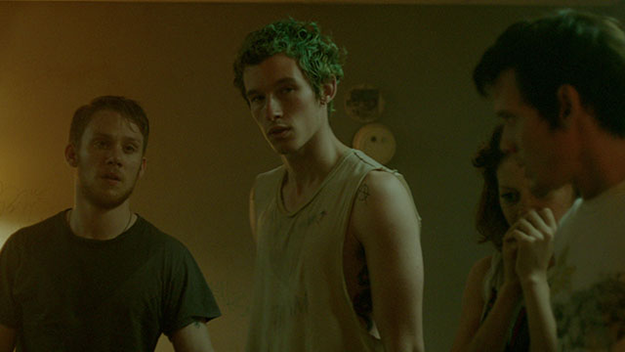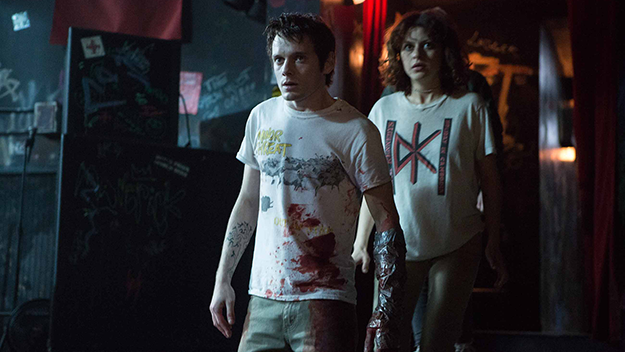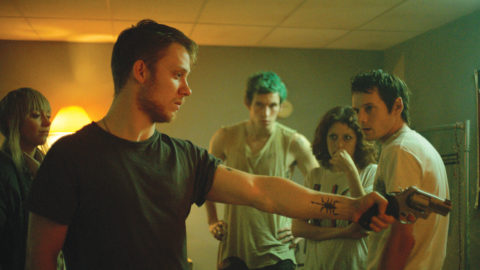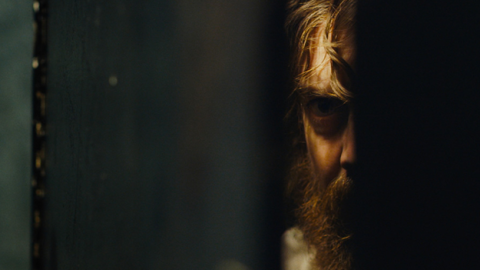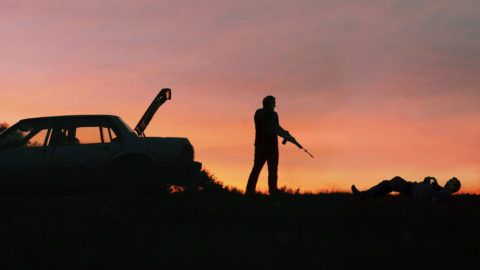Deep Focus: Green Room
Jeremy Saulnier shows a puckish sense of humor by dubbing his third feature Green Room after calling his breakthrough second feature Blue Ruin (14). But he told The New York Times that the newer movie is decidedly “not tongue-in-cheek.” Saulnier probably said that because in Green Room, a tongue is less likely to stay in place than to be ripped from the mouth and eaten by pit bulls. The plot is so simple that relating any part of it risks destroying the film’s aura of menace. Suffice it to say that a Virginia-based punk band on tour in rural Oregon gets pitted in a life-or-death struggle against the neo-Nazi drug-dealer/warlord (Patrick Stewart) who owns and runs a skinhead bar. This fight-or-die saga does feature a few fleeting drolleries; after a while, you desperately look forward to them. They should not have been just the comic relief—they should have been the comic raison d’être.
Saulnier’s instincts as a director outpace his abilities as a writer. He has designed this film to pay homage both to splatter films and to the better, more complicated movies that he first experienced in youth, such as John Boorman’s emotionally harrowing Deliverance and Sam Peckinpah’s complex, seminal Straw Dogs. Citing John Carpenter (Halloween) as an influence, he obviously shares Carpenter’s signal talent for horror that’s graphic in both an explicit and a pictorial sense. I think Saulnier has a richer sensibility than Carpenter’s, and that he ultimately wastes it in Green Room. There is something inherently sardonic about the premise. While the suspense is still ramping up, it’s piquant to consider who are the bigger poseurs—the nihilistic musicians or the fascistic thugs. Punk rockers like Saulnier’s quartet, The Ain’t Rights, thrive on generating violent, confrontational emotions. The neo-Nazis gain their power by whipping up similar feelings and (we soon see) acting on them. The movie reaches its peak when The Ain’t Rights challenge their audience by shouting out The Dead Kennedys’ “Nazi Punks Fuck Off.”
The musicians finish their set unscathed. It’s their misfortune to stumble onto a murder that compels their fascist hosts to keep them corralled in the club’s green room with the corpse. In the best splatter-film tradition, it takes a lot longer for The Ain’t Rights to accept the reality that unless they take action, they’re doomed, than it does for the audience. Green Room is scarcely rigorous or austere: Saulnier cuts outside the green room frequently enough to keep the audience ahead of the next piece of jeopardy, but not expansively enough to give you a full or fascinating picture of the white supremacists’ plans or ideology and culture. I guess that would be way too ambitious for this eager-to-be-B-movie.
The reactionary thugs’ fearless leader, Darcy Banker (Stewart), is intent on cleaning up the killing and wiping out any witnesses. One of the few clear motives for destroying evidence and onlookers is that Banker’s joint includes a drug operation in the basement. The movie becomes a succession of action tropes from siege and escape movies.
It’s effective in a high/low way; Saulnier is so talented that he keeps you hoping it will all add up to more than a visceral workout. His method of dribbling out the information as if with a pipet gives the film a stop-and-go narrative rhythm that keeps you off-balance. His scenario is embedded with dramatic face-offs that seem inexplicable at first, like a neo-Nazi bristling at an Ain’t Rights member mentioning his girlfriend. Then they reveal their scary logic.
Saulnier has shaped Green Room as a cinematic whirligig aimed to knot up your gut, then provide blissful relief when it’s over. The staging isn’t always as precise or as surprising as you wish for in a piece that’s an exercise in attitude and style. One of his most ingenious ideas, involving the use of sound feedback as a weapon, unfolds in an audiovisual muddle. Some of his calculated oddities—such as a skinhead checklist that contains (I think) all the items for a forensic cleanup, including “Meat Wolf”—are introduced awkwardly or self-consciously, as if he’s commanding the audience, “Pay attention!” But Saulnier plants loaded plot points cannily, then circles back to them just often enough to build up anticipation. When an attack dog roams away from the scene of the crime, the cuts to the canine, in particular, manage to pay off like a poignant/funny shaggy dog story.
If you’re not merely seeking cheap thrills, you may find the introductory scenes more engaging than the ensuing Night of the Living Brain-Dead. Saulnier has assembled an avid, talented group of actors for The Ain’t Rights, including Anton Yelchin as the bass player and Alia Shawkat as the guitarist. They brew a distinctive sweet-and-sour group aura. A prematurely mordant bunch, they dream of releasing LPs, they eschew social media, and they bury any deeper affection for softer rockers like Simon & Garfunkel. They’re ready to siphon gas from strangers’ tanks if they run out, and they’re willing to do a gig during a Mexican restaurant’s lunch hour—though the net pay of six bucks and change for each offends even their down-and-outers’ values.
Saulnier’s direction is at its nimblest early on. He displays genuine visual wit on every inch of the screen, whether his camera summarizes in a single overhead shot what happens when a van driver falls asleep at the wheel on a rural road, or a traveling shot depicts a bike that’s definitely not built for two. But the pithiness of these early sections may derive from Saulnier’s impatience to get to his money shots—say, a bad guy getting his torso sliced open or blood gushing from the knife wound of a corpse. Saulnier’s violence isn’t meretricious, or at least isn’t merely meretricious. He makes the mayhem frantic or clumsy and its outcome upsetting. But he’s caught in a limbo between lowdown gratification and a clear-eyed exploration of murderous destruction.
His actors are as hemmed in as their characters, but they sustain their superficially vivid personalities even in extremis. That includes Imogen Poots, who brings fresh air to blood and guts as a neo-Nazi who winds up on the side of The Ain’t Rights. Poots’s trademark—seductive derision—has never been more cannily exploited. And Stewart delivers an assured, refreshingly low-key star performance as Der Führer of the Oregon forests.
Still, Saulnier gives Stewart too little to work with for him to create a formidable mastermind. The drug business in the basement doesn’t come off as sufficient justification for Banker’s ludicrously over-complicated efforts to dispose of The Ain’t Rights without leaving a trace of them on the premises. (Wouldn’t it be easier to move the paraphernalia, at least temporarily?) Saulnier suggests that Darcy’s neo-Nazi unit is built on discipline and hierarchy; I wanted to know more about his Order of the Red Shoelaces. But Saulnier just wants to give audiences the illusion of complexity, and he isn’t enough of a sleight-of-hand artist to pull that off.
Although Green Room has more scope and technical ambition than Blue Ruin, artistically it takes a giant step back. Blue Ruin, too, had a basic suspense premise: a psychologically fragile vagrant slays the man he thinks murdered his parents, bringing the dead man’s family to an instant homicidal boil. But with the help of lead actor Macon Blair (who does intriguing work in Green Room as a skinhead with the instincts of a mediator), Blue Ruin brutally yet also lyrically limns the ultimate psychological descent of a misfit who’s been down so long that nothing looks like up to him.
In Blue Ruin, Saulnier displays an unusual sensitivity not only to peripheral vision but also to what could be called ambient vision—the sights that inform a person’s consciousness of a scene whether he or she is looking at them or not. Life doesn’t spill beyond the frame that way in the overly theatrical Green Room. Anything of substance is left waiting in the wings.
Michael Sragow is a contributing editor to FILM COMMENT and writes its Deep Focus column. He is a member of the National Society of Film Critics and the Los Angeles Film Critics Association. He also curates “The Moviegoer” at the Library of America website.



